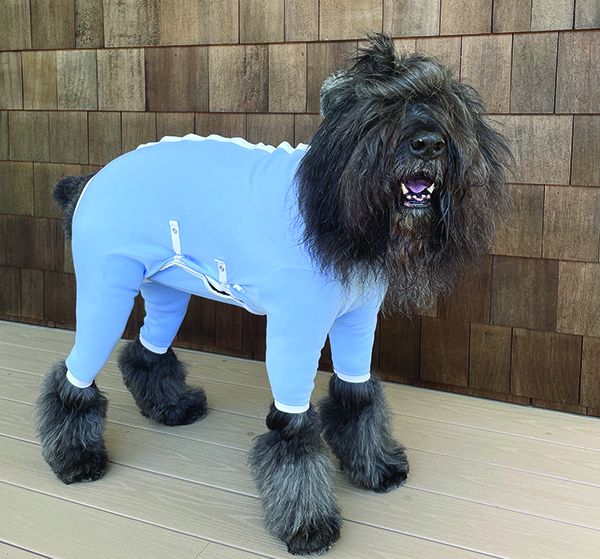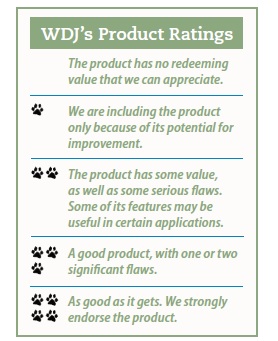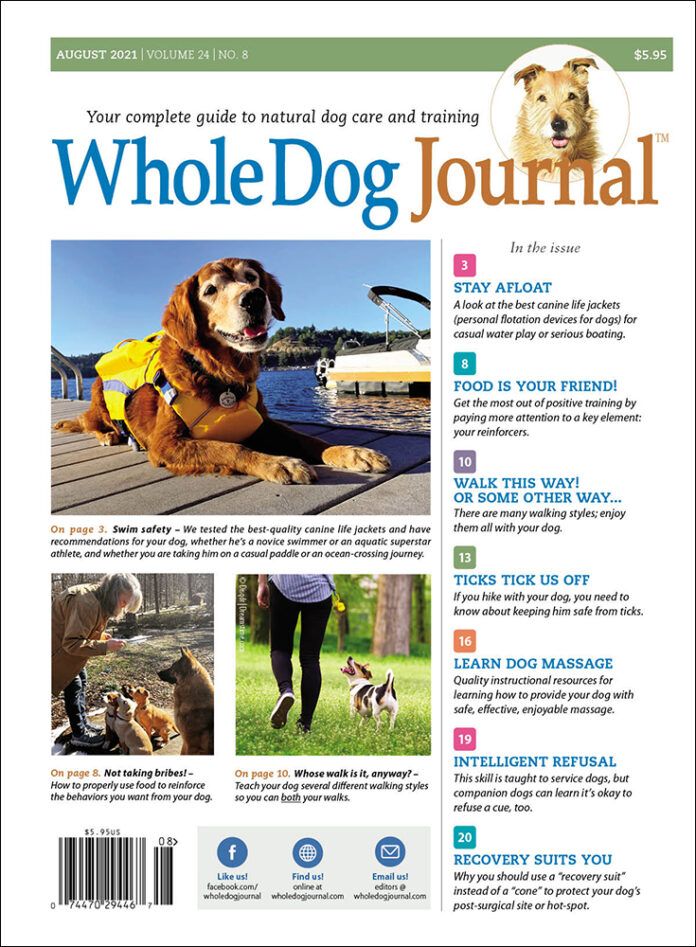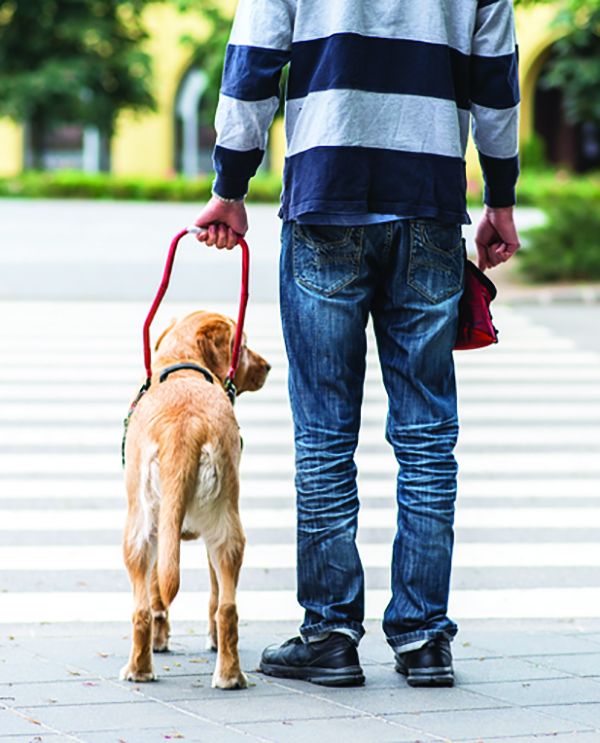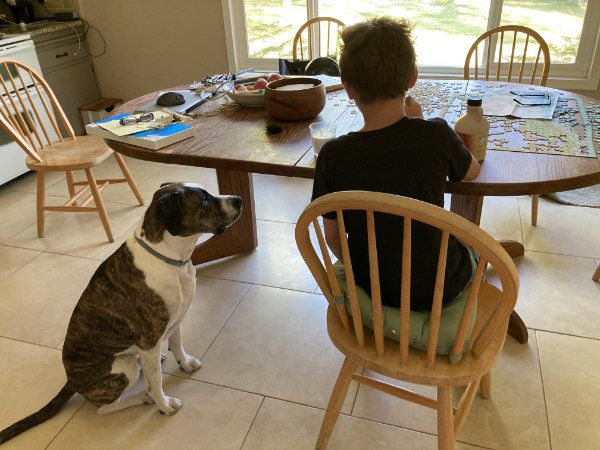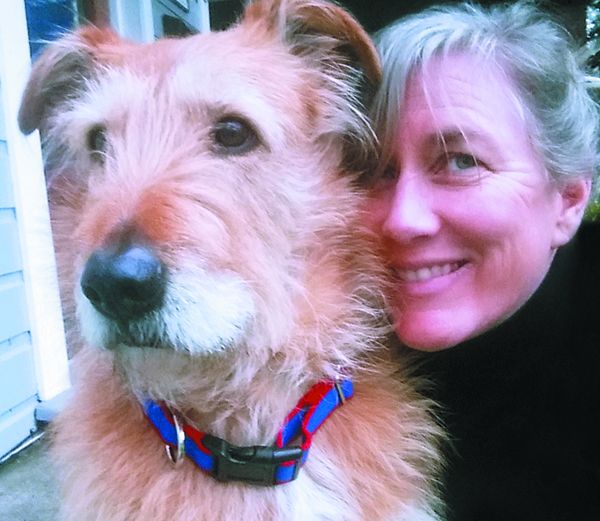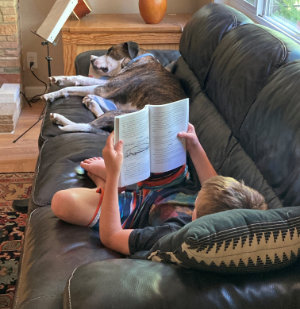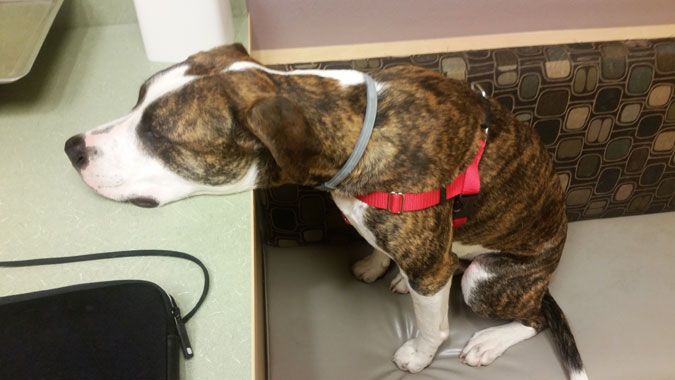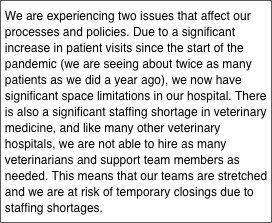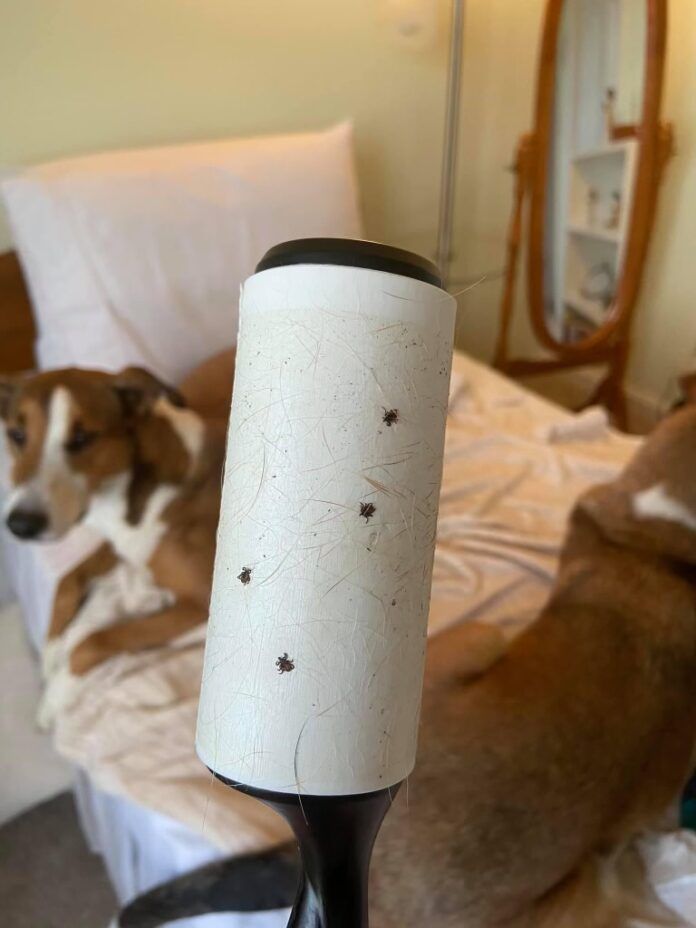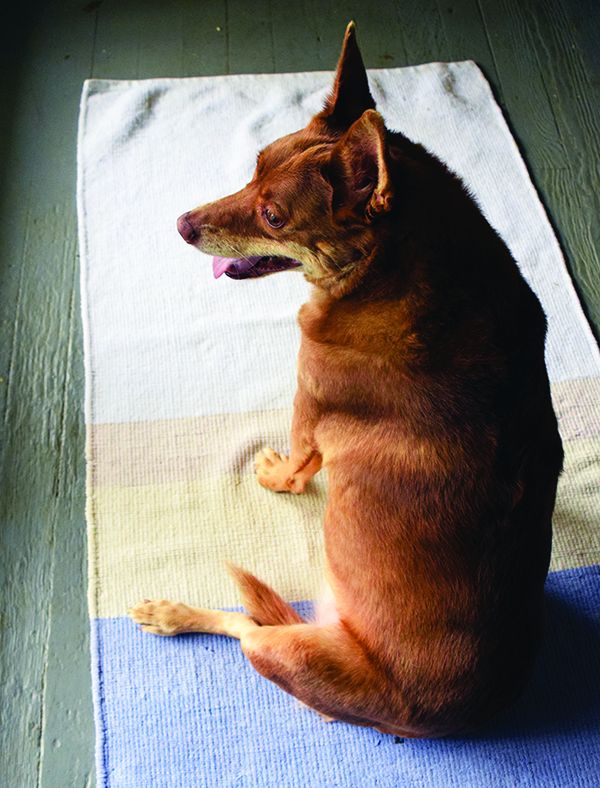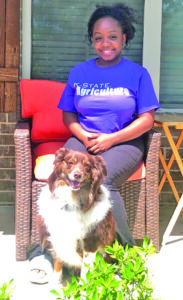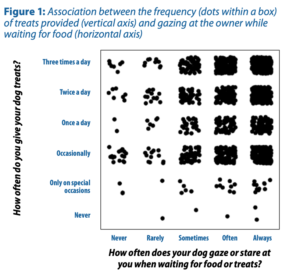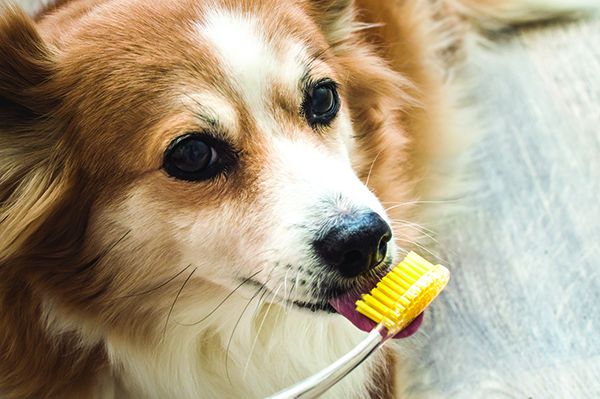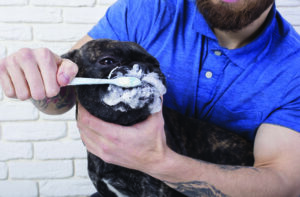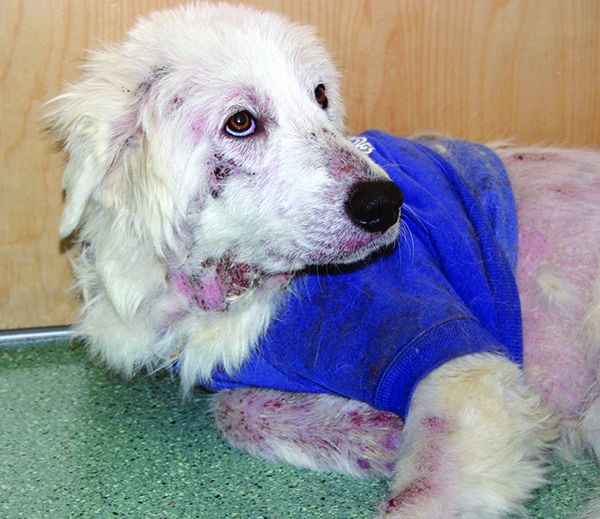I hate putting an Elizabethan collar on my dog – the dreaded cone that renders many dogs confused, depressed, or panicked. Yet, when a dog has a hot spot, wound, or surgical incision site that requires protection from his natural inclination to lick, the #1 go-to for veterinarians has always been the Elizabethan or e-collar. (We’re just talking about “cones,” not electric or electronic collars, which are also sometimes called e-collars.)
Thankfully, there are now quite a few alternatives to e-collars for protecting wounds and so forth. Today we will focus on one specific type of alternative: the recovery suit, a garment that is essentially a dog onesie.
For a rundown of other dog cone alternatives, see our recent review of your dog’s post-op options.
CONE CONCERNS
No doubt about it, most of the time, e-collars do what they were designed to do: create a protective barrier to prevent the dog from licking the area of concern. “Licking is a huge impediment to wound healing,” says veterinary dermatologist Tiffany Tapp, DVM, DACVD, owner of Veterinary Healing Arts in East Greenwich, Rhode Island, since the area remains moist and becomes the perfect breeding ground for bacteria and subsequent infection. “If caregivers can get their dogs to leave their lesions alone during that time, the dog will be well on their way to recovery. Coverage is essential.”
The problem is that most dogs find the experience of wearing a cone barely tolerable; there are stories of dogs who shut down, become frantic, refuse to eat or drink, or have any number of other adverse reactions to the contraption. Fitted with an e-collar, my own 9-year-old Bouvier, Atle, runs into furniture, gets stuck in small places, and definitely becomes depressed.
While the shutting down part may not sound so bad from a practical standpoint – most dogs recovering from surgery or injury need to be kept quiet – distress and depression are not good for healing.
And, physically speaking, there are compelling reasons why some veterinary health care providers are not fans of cones. As someone who sees dogs with ear issues almost daily, Dr. Tapp prefers recovery suits over e- collars because the giant cones sit immediately behind the ear and do nothing to protect the dog’s neck. She also notes that e-collars cause heat and humidity to build up, exacerbating ear issues.
Debbie Gross Torraca, DPT, MSPT, CCRP, CCMT, is the founder of Wizard of Paws, an animal physical therapy practice in Colchester, Connecticut. She explains that she would rather see a dog wear anything but an e-collar. “I find them so invasive and stressful for the cervical spine. And the visual or anti-visual impact of the e-collar can really mess up some older dogs with pre-existing conditions, negatively affecting their vision and proprioception.”
A T-SHIRT WON’T DO
Atle and I had our own experience dealing with e-collars and recovery suits after he had two benign growths removed – one on his mid-back, and the other on the back of his hind leg. Despite his primary care veterinarian sending us home with instructions to use an e-collar, I didn’t. He wasn’t worrying the incisions, and I thought we were home-free.
Unfortunately, days later, I realized that Atle had licked his leg incision; we were soon on our way to see Dr. Tapp, who diagnosed both incisions as being infected and missing sutures. Dr. Tapp recommended a recovery suit, a t-shirt, or an e-collar. Initially, I rigged up a covering using a t-shirt and my cycling leg warmers. My homemade version kept falling off.
I finally ordered a Cover Me by Tui post-surgical garment – and it was a game-changer. No longer did I have to constantly check his garments for slippage, and I could dine in peace without having to listen for the dreaded sound of a dog licking an incision. Atle accepted the suit much more gracefully than he does an e-collar.
I’m a convert to the recovery suit as an alternative to an e-collar, but before you slap a suit on your unsuspecting dog, consider these points:
• Plan ahead. Like muzzles, ramps, and other equipment that take getting used to, if possible, make your purchase before you need it. If your dog has a surgery scheduled for next month, buy now! Then, both you and your dog can acclimate to it – your dog for comfort, you for ease of use.
• Most companies recommend that the dog wear the suit for a finite amount of time. Shed Defender, for example, says no more than eight hours a day. Monitor your dog for signs of overheating, and regularly check for matting when the suit comes off.
• If your dog has a significant recovery ahead of them, consider getting two suits so that one is still available while the second is being laundered.
• Choose a suit that accommodates your dog’s medical condition or disability. For example, an older, arthritic dog may do better with a back closure suit that doesn’t require limbs to be manipulated.
• Keep your dog’s nails trimmed; long nails and Lycra don’t mix well.
• “Measure twice, order once.” Look at the company’s website for measuring guidelines or call the company for help.
SO MANY OPTIONS
I don’t know why I hesitated to order a recovery suit; the business is booming with products marketed for a variety of uses: controlling shedding, calming anxious pets, covering hot spots, preventing licking and chewing, UV protection, allergy prevention/relief, wound prevention, protection from ticks and burrs, visibility, and management of incontinence and heat cycles. A quick web search turns up countless options, from cheap knockoffs to pricey, sleek, high-tech models.
As a former professional in the rag trade, I’m particular about garment construction and fabric. I started my search for a suit that would comfortably fit Atle – and that I could easily get him into. Other considerations included laundering, price, sizing, type and location of closures, how the garment went on, coverage, durability, and how the dog is expected to eliminate while wearing the suit.
I selected a number of products to try, and then considered them in three categories: long-sleeved suits (to cover any points on the dog’s legs or multiple sites on the dog); sleeveless body suits (for use when conditions are limited to the dog’s trunk or neck); and sleeve-only products. The latter were a late discovery – I reviewed only one.
PRODUCTS WITH SLEEVES
*Cover Me by Tui. The 100% cotton material of this long-sleeved suit is soft, breathable, and durable. The suit offers quality construction, was easy to put on (due to a relaxed fit), with no zippers to snag hair. You have to bend your dog’s legs to put on the over-the-head model, though less than with spandex suits. Atle isn’t a fan of clothing going on over his head, so we both appreciated the step-in, back-snap model.
We tested a size XL, which was a snug fit for Atle and even more so for Holden. The over-the-head model was an XXL and was a less restrictive, almost too-roomy fit, although both models feature snaps on the sides that can be used to adjust the girth.
The “potty flap” can be a little challenging to navigate because of the number of snaps (16 on the XL!) required to secure it. The neck is a wide band of fabric of moderate height, though maybe less than ideal if neck coverage is a concern.
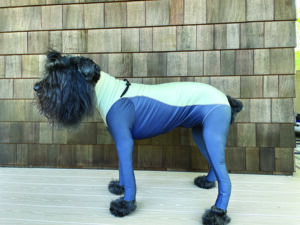
* K9 Top Coat Full Cover Bodysuit. This suit has a very sleek, high-tech look and feel, and was the most expensive product I tested – but in this case, you get what you pay for. The suit is well constructed and features top stitching; it’s made from a 6 oz. Lycra blend with a nice hand weight (is not flimsy) and that, the company claims, offers anti-allergenic, fungicidal, and bactericidal properties.
The full length, sturdy zipper runs from the neck to just under the dog’s tail, requiring it to be unzipped slightly to allow the dog to eliminate. I love the fabric guard under the zipper that prevents hair from getting caught, though, given the quality of the garment, I was a little surprised at the lack of a zipper “garage” (a fabric housing for the zipper pull tab).
A Velcro tab at the neck provides extra security, and the garment’s neck snugly covers all the way up behind the ears. An adjustable strap runs the length of the back and can be used to shorten the suit.
Putting the suit on wasn’t difficult, though it does require you to bend your dog’s legs. Atle is not a fan of a snug fit, and did a lot of shaking off and acting subdued, but perked up and moved normally outdoors.
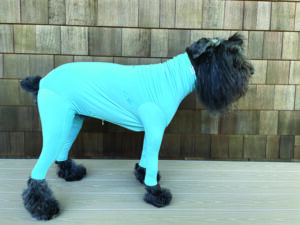
* Shed Defender Sport. Made from a proprietary 80/20 polyester/Lycra blend, the Sport model features a lightweight, 7-inch, easy open/close zipper that runs from just behind the front armpits to mid-belly, meaning no unzipping is required for the dog to urinate. Additional shirred elastic banding extends from the belly end of the zipper to behind each leg to keep the garment in place. The Sport provides good coverage of the neck.
For Atle, I bought the XL size, which is indicated for dogs from 61 to 84 pounds, but the product is a little on the snug side and seemed to restrict his movement a bit.
The “hand” of the fabric (how it feels to the touch) was a little light; when asked, the company was unable to provide me with the weight of the fabric. Whatever its weight, it seems too light and not durable enough, especially for big dogs. When I stretched one of the seams on the garment, a rough fingernail edge inadvertently caught the fabric and made a tiny hole.
That said, the Sport is about half the price of the K9 Top Coat and could be an option for the dog owner on a budget.
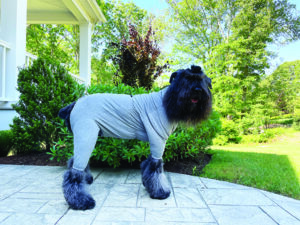
* Heywean Long Sleeve Dog Surgical Recovery Suit. Beware of knock-offs! I was interested in this suit because it had a full-length back zipper, but the product arrived with a split seam and the sleeves are more ¾ than full length. A low-quality product for a moderate price ($37 – $50).
SLEEVELESS SUITS
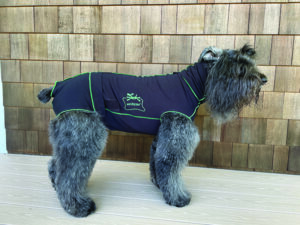
* Medipaw Protective Suit. This suit is made from a cotton/Lycra blend with a substantial weight and feel. The two-piece garment features “pants” that look like briefs, and a sleeveless “top.” The pants have two leg holes and a tail hole, while the top has two leg holes.
Since the top goes on over the dog’s head, each front leg needs to be lifted and bent to fit through the leg openings. Though the pants can’t be worn alone, the top can. On Atle, it extends all the way to his groin, and because of the garment’s “compressive” nature is less likely to ride up than a t-shirt. When the top is worn with the pants, the top affixes to the pants via wide Velcro strips. The top’s neck is high, offering ample neck protection (earning plaudits from Dr. Tapp) and the ability to be folded down like a turtleneck.
The top features a large internal pocket for ice packs or absorbent pads. The company advises sizing down if in doubt, since the garment stretches a little during use.
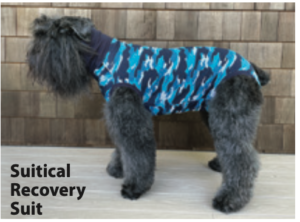
* Suitical Recovery Suit. The sleeveless Suitical is made from a nice-feeling, robust cotton/Lycra fabric. The garment is simple and well made, with a high neck that has loops inside through which a collar can be run. Soft, non-restrictive bands of fabric line the leg holes. The suit goes on over the head, and you have to bend the dog’s front legs to get them through the “arm holes.” There are no hind leg holes to navigate; instead, the back of the suit snaps near the tail to secure the garment.
For bathroom breaks, you unsnap the garment and fold/roll the fabric toward the dog’s chest, where a tab sits to secure the flap while the dog eliminates.
This would be a great option for us if we had to deal with ear issues or hot spots on his chest, armpits, neck, or belly. Atle overheats easily, so a sleeveless garment would be a great option provided it covers the areas of concern. The company also makes front leg “recovery sleeves” that could be used in tandem with the suit for additional coverage when needed.
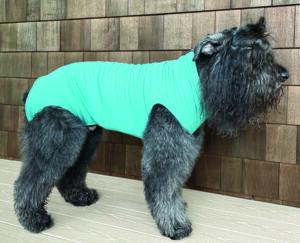
* VetMedCare Bodysuit. The VetMedCare suit we tested was a sleeveless over-the-head stretchy tube with four leg holes, available in male and female versions. I wanted to like this product because of its light weight, simplicity, and long sleeve/sleeveless models. But I question the product’s long-term durability; after one laundering in cool water, the suit stretched out and didn’t bounce back.
SLEEVE ONLY
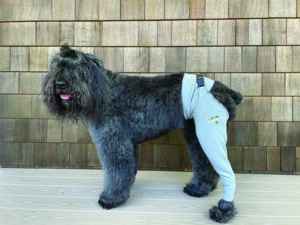
* Lick Sleeve. I discovered this departure from a “suit” late in the game and reviewed only this one: the Lick Sleeve. Designed by a veterinary surgeon, it’s for the hind leg only, but in an ingenious design, can be turned inside out in order to fit either the left or right leg. The sleeve offers full coverage and is simple to put on. Were my dog to have cruciate surgery, this lightweight sleeve would be my pick.
Available in three sizes (for dogs 30 pounds and up), the product is not inexpensive, but compared to the cost for additional veterinary care if the dog disturbs the health of a surgical incision, it’s well worth the price.
RATING “RECOVERY SUITS” IN VARYING SLEEVE LENGTHS
| Product, WDJPaw Rating | Sizes, Price | Material, Laundering | How it goes on | “Bathroom” Access | Comments |
|---|---|---|---|---|---|
| LONG AND SHORT SLEEVE SUITS | |||||
| Cover Me by Tui (800) 208-6170 tulanescloset.com 3 out of 4 Paws | 7 sizes $30 - $47 | 100% Peruvian Cotton. Machine wash cold; tumble dry low. | Over the head and step-in (secured by dorsal snaps) models. Moderately high neck. | Unsnap, roll and secure terry cloth-lined “potty flap.” | Long and short sleeve models. Leg length not adjustable. Special orders possible. Quality materials and construction at a good price. |
| K9 Top Coat Full Cover Bodysuit (888) 833-5959 K9topcoat.com 3 out of 4 Paws | 10 sizes $92 - $106 | 82% nylon, 18% spandex. Machine wash cold; line dry or tumble dry delicate. | Over the head with full length ventral zipper with zipper guard. High neck. | Unzip for males. | Tested by UC Davis School of Veterinary Medicine. Made in USA. Company offers lifetime warranty against defects in material and workmanship. |
| Shed Defender Sport sheddefender.com 2.5 out of 4 Paws | 9 sizes $40 - $63 | 80% polyester, 20% spandex (Shed-Tex, made from recycled bottles). Machine wash; tumble dry low. | Over the head with ventral zipper that stops at stomach; no zipper guard. Moderately high neck. | “Sport” allows elimination without unzipping; “Original” must be unzipped. | Long sleeve. “Original” model has ventral chest to tail zipper. Sleeveless bodysuit also available. 30-day risk-free trial. |
| Heywean Dog Surgical Recovery Suit Amazon.com 1 out of 4 Paws | 8 sizes $26 - $40 | 95% cotton, 5% spandex. Cold wash, line dry. | Full back zipper/step in. | Fabric may be cut for male dogs. | Chinese import sold online only; no company information or website available. Low-quality. |
| SLEVELESS BODY SUITS | |||||
| MediPaw Protective Dog Suit (800) 245-3413;medipaw.com 4 out of 4 Paws | 8 sizes $37 -$51 | 94% cotton, 6% Lycra. Machine wash cold; line dry. | Over the head; front and back pieces joined by Velcro. High neck. | Remove “pants” and/or roll up front piece. | Two-piece design. “Top” piece may be worn alone. Well-made product at an attractive price point and available in a wide range of sizes. |
| Suitical “Recovery Suit” suitical.com 4 out of 4 Paws | 10 sizes $35 - $40 | 95% cotton, 5% Lycra. Machine wash; line dry. | Over the head with snaps at rear. High neck. | Unsnap and tuck in/roll up fabric, secure with snap. | Designed in collaboration with veterinarians. Simple, well-made product, at an attractive price point, in a wide range of sizes. |
| VetMed Care Bodysuit Available from jorvet.com 1 out of 4 Paws | 12 (female and male options in 6 sizes) $23 - $36 | 90% polyamid, 10% elasthan. Machine wash hot; tumble dry low heat. | One piece, over the head, no closures. | Small opening in suit for males. | Not very durable; stretched out after one laundering. |
| HIND LEG | |||||
| Lick Sleeve (855) 989-3733 Licksleeve.com 4 out of 4 Paws | 3 sizes $85 | Polyester/spandex blend. Machine wash; line dry. | Wrap with buckle closure. | Remove sleeve for male dogs. | Good option for CCL/hind leg issues. Smallest size for dogs >30 lbs. Created by a veterinary surgeon. Length may be cut to shorten. Made in USA. |


